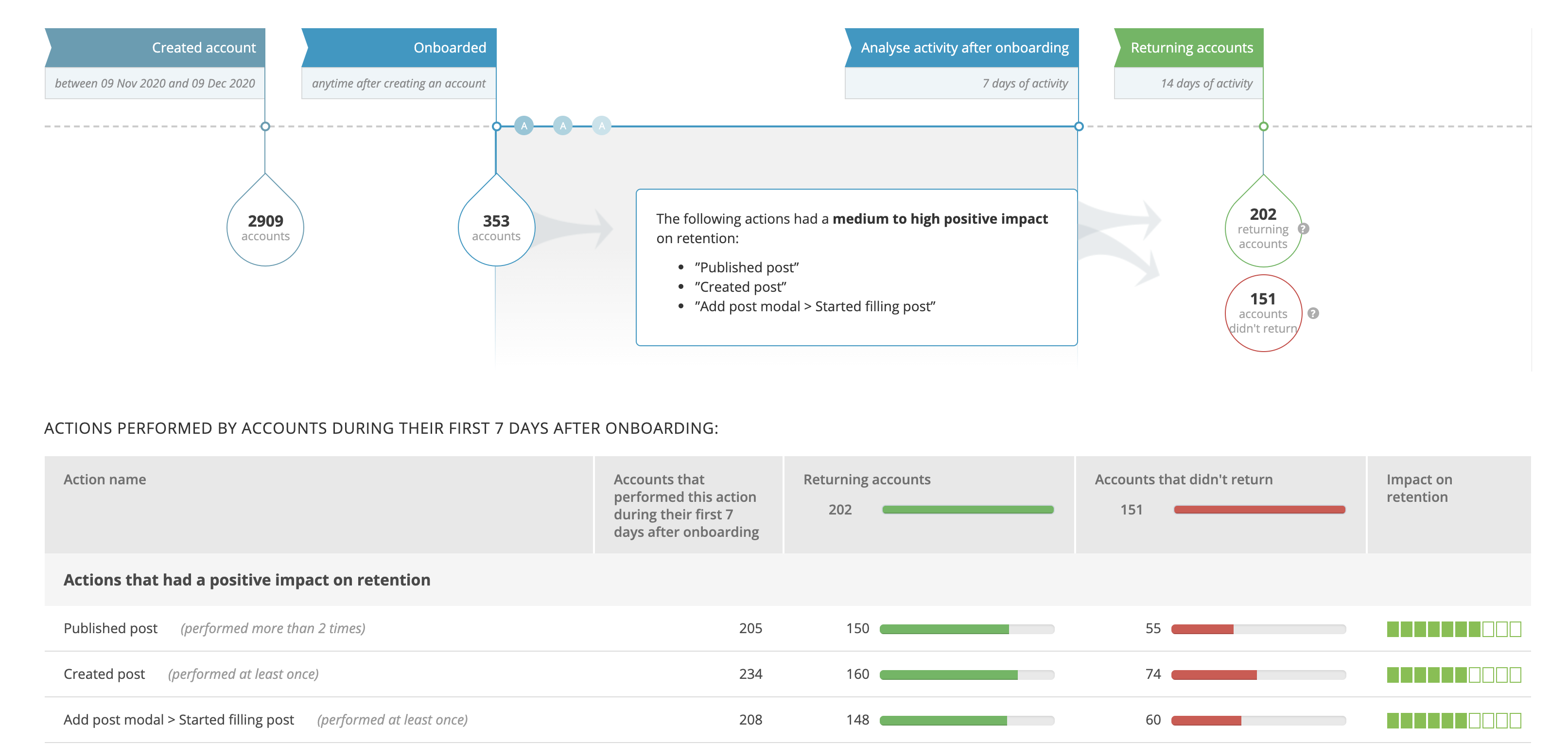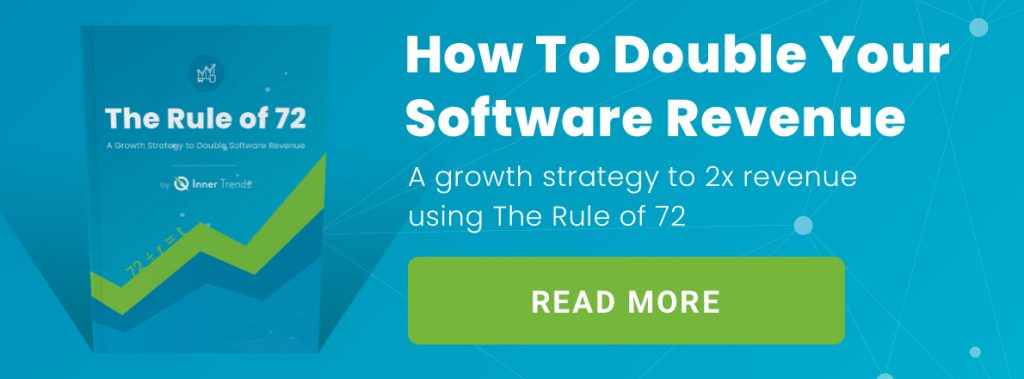Step 4 of 5 on how to double your SaaS revenue using the rule of 72.
In the last several posts we’ve talked a lot about the rule of 72, and changes you can make to double your revenue. We’ve shared how to increase traffic to your website. We’ve discussed ways to increase your signup conversion rate and your onboarding conversion rate.
|
Overview: Getting Started with the Rule of 72 for Doubling your SaaS Revenue |
| Step 1: Visits – From Stranger to Visitor |
| Step 2: Creates Account – From Visitor to Sign-up |
| Step 3: Get Onboarded – From Sign-up to Onboarded User |
| Step 4: First Week Retention After Onboarded – From Onboarded User to Returning to the Product within 1 Week |
| Step 5: Upgrade to a Paid Account – From First Week Retention After Onboarded to Paying Customer |
At this point, you have done a lot of heavy lifting getting visitors to sign up and users to experience the initial value and promise of your business. Now, we’re at one of the most exciting stages in the customer journey – retention. After all, it’s the SaaS business’s ability to retain customers that attracts investors and gives your business the ability to weather most economic downturns. (Kinda important to get this part dialed in!)
The question we’re going to tackle today is:
How can you improve your retention (first-week retention after achieving onboarded in this case) by a mere 15%?
There’s a world-famous ice cream spot in Portland Oregon called Salt & Straw. Anyone can get ice cream from any grocery store, yet on any given summer evening (even during the pandemic!) you will find a line around the block, just to get one of these scoops. People keep coming back, waiting in long lines, exposing themselves to some very strange flavors, yet they come back. So what is Salt & Straw doing differently? What makes them unique?
The glaringly obvious fact is, they aren’t just selling ice cream, they’re selling an experience. Whether it’s the creation of unique flavors, consistent recipes, simple FOMO after seeing the long line outside, or hearing from a friend about a great little ice cream joint, Salt & Straw is creating an excellent experience that helps with not only potential customer’s initial taste testing, but by getting this right it attributes to additional business growth.
A user has decided to grab the world’s best ice cream, they’ve committed to standing in a very long line. So what does Salt & Straw do? They send their sales people out into the line providing tasting samples. By the time the user has reached the cash register, they have chosen their flavor and decided on their purchase. Now they are holding a dripping ice cream cone over the counter as their credit card is getting swiped.
Translation: there’s a gap between the onboarded user (they’ve tasted their first sample and decided on Salt & Straw today) and when they have to pay (at the sticky register). Just like this ice cream company, what you do with the user while they are waiting in line is exactly what we mean when we say first week retention after onboarded. We are not talking about long term retention here, but what users are doing in your software before they pay you.
In the terms of the ice cream shop they are trying additional samples (coming back to the product after achieving onboarded) to determine what flavor they want (if they want to upgrade or not) to then pay for it (upgrade to a paid account).
Shortest Period + Maximum Data
In our ice cream example, there could be 6 flavors of ice cream samples being taste tested by potential customers in line. Wouldn’t it make sense to analyze which flavors were purchased most that day to determine which ice cream flavors might be purchased more for the next line of potential customers and also lead to better repeat customers?
That being said, using your product analytics tool, you should focus on creating a cohort of users who behave optimally in the shortest amount of time.
Let’s say we have a 14-day free trial. Usually if a user doesn’t come back within the trial period then the first experience wasn’t of much value and they are most likely to not continue assessing the product any further. To work through this problem you would need to return to Step 3 of 5, the previous article on improving user onboarding in order to get your users to onboarded (the promise of your business).
However, if we look at the cohort of users that did return in the first 7 Days (First Week Retention) after onboarded and their common conversion activity, it will give you some deep insights in how to get users to come back to the product to explore a bit more and hopefully upgrade to paid since they have clearly experienced the full promise of your business. You now have your cohort of ice cream loving tasters / users.
Here is the question you are looking to answer:
- What are the top actions this cohort is doing that leads them to come back to the product within the first 7 days after onboarded?
Strike While the Iron is Hot, or While the Ice Cream is Still Cold
Once you have those happy user actions / events identified you will have a clearer picture of how to increase your first week retention rate after onboarded and in-turn get more users to come back to the product to explore more and hopefully upgrade to a paid account.
If you want to drill into the data yourself, at InnerTrends, we have a report called What are the differences in actions between onboarded accounts that return and those that churn? Yep, right out of the box, baby! How do you like that flavor?
Here is how it looks:

Using this information, you can clearly see the actions that users are taking have a positive impact on retention after achieving onboarded to put test in place to increase your onboarded to first week retention conversion rate by 15%. Just a few simple adjustments may be all you need to double your growth.
Taking Action
Here are a few ideas on marketing and growth experiments you may want to try inside and outside of the product to increase your first week retention rate after onboarded once you know what actions you are trying to help your users achieve more of:
Leverage Event Trigger Notifications
Using Intercom or other tools, you’ll be able to reward “good behavior” or even trigger reminders when certain behaviors are not taken. Mold your messaging around the user’s behavior.
Adopt a More Agile Release Schedule
The cool thing about Agile is that there’s a constant release of small improvements to the product. Each of these minor improvements gives you an excuse to talk to your user and drive excitement about what you are doing. Note: be sure to track the impact of these as well.
Experiment with Different Walkthrough Paths
Using tools like Appcues, experiment with different user onboarding experiences. Maybe you’ve made some assumptions about the most important first 3 user experience steps in your app and it may make sense to try a different set of steps, or even reversing them, then compare with previous data.
KLT Campaigns to Build Community
KLT, or Know/Like/Trust is a communication strategy that focuses less on the features or capabilities of a product and more on education and personalizing the brand. Here, you’ll think about ways you can educate your user to make their life easier, not on your product but on something else related. Ideally, you’ll be able to relate these helpful articles or emails with the specific steps your happy ice cream eaters are doing.
Discover Related Jobs to Fill Success Gaps
As your user grows and evolves from using your solution, new needs may arise. For example, after they learn a ton of cool stuff at a conference, maybe they’ll need help staying motivated. Or, after they’ve purchased that barbeque, they’ll now need help figuring out how to cook! Can you identify the tangents surrounding your solution?
Retarget on Social Media
The amazing thing about tools like the Facebook pixel and Google cookies is you can track your users, and then remarket your solution to them. Have you ever seen an ad online that asked you to come back or complete a purchase? “Finish setting up your account and we’ll send you a free ebook”
I hope this information helps with the improvement of your first week retention rate after onboarded. If you have any questions please leave a comment below and we would be happy to help. Or grab a demo and we can show you exactly how to go about this in InnerTrends live.
Get the Complete eBook on How To Double Your Software Revenue
While we’ve covered a lot in this post, believe it or not, we’ve barely scratched the surface of things you can do to double revenue in your SaaS company. We invite you to download the complete eBook to get insights on the rest of the steps for doubling the revenue of your business

